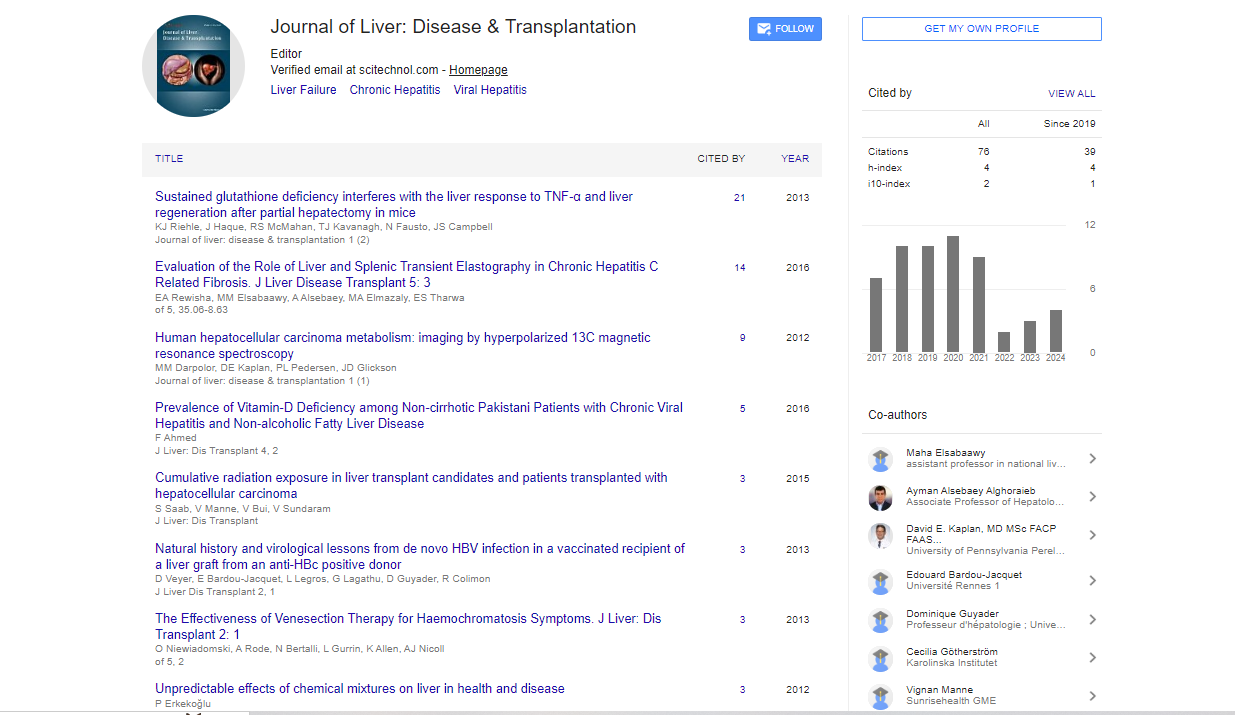Opinion Article, J Liver Disease Transplant Vol: 13 Issue: 4
Advances in Regenerative Medicine and Stem Cell Therapies for Liver Cirrhosis
Lauren Magaz*
1Department of Gastroenterology and Hepatology, University Medical Center, Rotterdam, The Netherlands
*Corresponding Author: Lauren Magaz,
Department of Gastroenterology and
Hepatology, University Medical Center, Rotterdam, The Netherlands
E-mail: mlaur@eti.umcr.edu
Received date: 28 November, 2024 Manuscript No. JLDT-24-156889;
Editor assigned date: 02 December, 2024, PreQC No. JLDT-24-156889 (PQ);
Reviewed date: 16 December, 2024, QC No. JLDT-24-156889;
Revised date: 23 December, 2024, Manuscript No. JLDT-24-156889 (R);
Published date: 30 December, 2024, DOI: 10.4172/2325-9612.1000291.
Citation: Magaz L (2024) Advances in Regenerative Medicine and Stem Cell Therapies for Liver Cirrhosis. J Liver Disease Transplant 13:4.
Description
Advances in regenerative medicine have significantly contributed to the development of novel therapies for complex conditions such as liver cirrhosis. Liver cirrhosis, a condition characterized by progressive liver damage and the formation of fibrotic tissue, often leads to liver failure, increased mortality and limited treatment options. The traditional approach primarily focuses on managing symptoms, slowing disease progression and occasionally employing liver transplants. However, these treatments are not always accessible and the demand for more effective solutions has driven studyers to analyze regenerative medicine, particularly stem cell therapies, as a potential path toward restoring liver function. Stem cells have the remarkable ability to self-renew and differentiate into specialized cell types, offering immense potential for tissue regeneration. Liver cirrhosis arises from the inability of the liver to effectively regenerate damaged cells, which leads to fibrosis and impaired liver function. Stem cell therapies aim to address this by introducing healthy cells capable of replenishing damaged liver tissue, restoring function and reducing the associated scarring.
Mesenchymal Stem Cells (MSCs) have emerged as one of the most promising candidates for liver regeneration. These cells can be harvested from the patient’s bone marrow, adipose tissue, or other non-liver tissues. MSCs possess immunomodulatory properties, which help reduce inflammation and reduce fibrosis, two important aspects of liver cirrhosis. Clinical trials involving MSC therapy have demonstrated improvements in liver function, a reduction in fibrosis and even enhanced survival rates. For example, several studies have reported that MSC transplantation can lead to improvements in liver enzyme levels, decreased portal hypertension and an overall increase in the quality of life for patients. Furthermore, MSCs can potentially differentiate into liver cells and contribute to the repair of damaged liver tissue. Another key stem cell type being analyzed for liver cirrhosis treatment is Induced Pluripotent Stem Cells (iPSCs). Unlike MSCs, iPSCs are generated from a patient’s own somatic cells, typically skin or blood cells, by reprogramming them to an undifferentiated state. This patient-specific approach eliminates the risk of immune rejection, a common challenge in many regenerative therapies. iPSCs can then be differentiated into hepatocyte-like cells, the functional cells of the liver, which have the potential to replace damaged liver tissue. Studies involving iPSCs have shown the ability to create functional liver cells in vitro and even to integrate into liver tissue when transplanted into animal models. The assurance of iPSCs lies in their capacity to generate personalized therapies, offering treatment that is tailored to each patient’s unique needs and genetic profile.
While the potential of stem cell therapies is immense, several challenges remain that need to be addressed to fully realize their clinical utility. One of the primary concerns is ensuring safety and efficacy. Stem cell-based therapies require rigorous testing to confirm long-term safety, avoid immune rejection and ensure that the cells differentiate appropriately into functioning liver cells. The production of MSCs and iPSCs requires precise protocols for isolation, expansion and differentiation, which need to be standardized and optimized. Another significant challenge is the scalability of these therapies. The process of generating and delivering stem cells on a large scale requires significant financial investment and specialized infrastructure. Developing cost-effective strategies for cell production, quality control and storage will be important in ensuring these therapies become accessible to a broader population. Additionally, regulatory hurdles and the need for long-term patient monitoring further complicate the clinical application of stem cell therapies.
Long-term outcomes and durability of the regenerative benefits provided by stem cell therapies also remain an area of active investigation. Questions around the longevity of the newly formed liver cells, the potential for long-term engraftment and the risk of malignancy are ongoing concerns. Study focusing on mechanisms of liver regeneration and the signals that control stem cell differentiation is essential to reduce these risks and enhance therapeutic success. Clinical trials are fundamental in demonstrating the safety, efficacy and durability of stem cell therapies. Several ongoing trials are exploring the potential of both MSCs and iPSCs, with initial results showing assurance. For instance, some clinical trials have already reported improvements in liver fibrosis, reductions in the need for invasive procedures like liver transplants and improvements in liver function in patients treated with MSCs. These promising results support the continued development of regenerative therapies for liver cirrhosis, offering hope for more effective and personalized treatments.
Conclusion
Stem cell therapies, including MSCs and iPSCs, hold great assurance for treating liver cirrhosis. While challenges such as safety, scalability and long-term efficacy need to be addressed, ongoing study and clinical trials are paving the way for innovative, personalized treatments. The future of regenerative medicine in liver cirrhosis could transform the management of this condition, offering patients improved outcomes, reduced reliance on invasive procedures and better quality of life. As the field continues to develop, stem cell therapies have the potential to become a foundation of treatment, bringing hope to millions affected by this chronic disease.
 Spanish
Spanish  Chinese
Chinese  Russian
Russian  German
German  French
French  Japanese
Japanese  Portuguese
Portuguese  Hindi
Hindi 